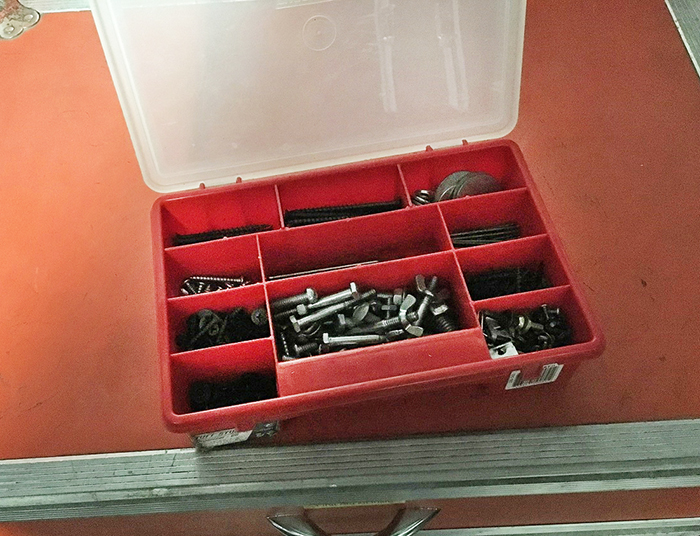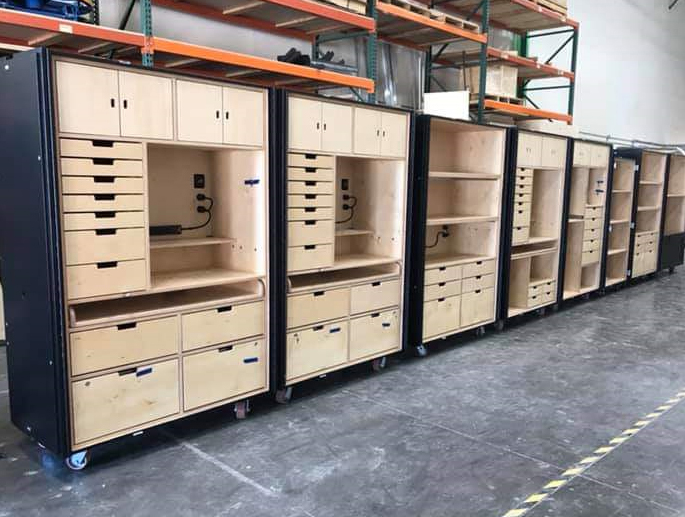Early in my pro audio career, I was working a touring show as part of the local crew, unloading a truck. Inside it was a beat-up red Craftsman tool chest drawer unit on wheels, strapped to the wall.
A member of the sound crew yelled into the truck that this “workbox” went over in monitor world. I unstrapped it and pushed it to the stage, but not before peeking into the many drawers. One was loaded with tools as you might expect in a tool chest, but most were loaded with audio adapters, interface boxes, cables and gaff tape.
During setup, the monitor engineer reached into that old workbox more times than I could count, getting adapters to interface his PA with the house system, grabbing tools or a flashlight to fix something or getting gaff for us local hands so we could tape down his cables. Even though I’d worked a lot of local gigs, I’d never seen or even thought of a workbox before, but I really liked how all the bits and pieces that make a show happen could be organized in one place.
A Go-To Resource
Today, more than three decades later, there are many styles of workboxes, ranging from touring boxes built out of wood to ATA flight cases that offer a lot of drawers, but they all basically do the same job: keeping the key tools and components that make a show happen organized.
My company has a multi-drawer show workbox that’s full of everything we can think of that might be needed at gigs, as well as a few specialized workboxes that are intended to be used with a specific department like lighting or backline on larger gigs.
While most technicians carry a few personal tools or items to shows, a workbox is more of a company supplied item that holds more stuff than a stage tech could carry. Like that monitor engineer with the red Craftsman box, we reach into our workboxes multiple times when setting up. Here are some of the key items they carry.
Adapters and Turnarounds – There can never be enough adapters at a gig. They’re always needed for interfacing with rental gear, the house PA or a client’s playback equipment. The ones I use the most are XLR Turnarounds (a.k.a., XLR male to male and female to female connectors), 1/4-inch TRS to XLR, and 1/8-inch TRS (3.5 mm) to everything (1/4-inch TRS, RCA and XLR).
Cables – We carry several long 1/4-inch to 1/4-inch signal cords for musicians who don’t have (meaning they forgot it at the last gig) one for their electronic instruments, and we also include a short “head-to-cabinet” 1/4-inch loudspeaker cable in the workbox.
Speaking of musicians, we also carry a few other items that always seem needed, including drum keys, a set of sticks (so we can do a drum mic check before the drummer gets onstage), and an assortment of picks because guitar players always seem to need them.
Note, when my company is providing the backline for a band, we also take out a 4-drawer Calzone workbox loaded with strings, cleaners, tubes, pedals, sticks, and even an assortment of drum heads to service the band and our equipment.
Short Cat (Ethernet) Cables – Jumpers about 5 to 6 feet long with standard RJ45 connectors always come in handy these days. We have a few around to implement (Audinate) Dante networking, connect gear to network switches, and the odd times when can actually connect a laptop to the internet.
Spare Power Cords – Sometimes cords don’t make it back to the right case so a handful of standard IEC and PowerCon cables always come along just in case.
Switches and Routers – A few basic NetGear gigabit switches travel in a drawer for Dante networking and a Linksys router that we can use to connect an iPad to a console for remote mixing.

Test Gear and Meters – My favorite test tool, the Whirlwind Q Box, can verify a signal is present; just send a test tone down the line. Every workbox should also have a VOM meter (volt-ohm-millimeter) to check AC power and verify that it’s correct (or not).
If we’ve never worked in a venue before, we check the voltage of every outlet. If a house electrician has hooked up our tails or feeder, we double check it with a Fluke 321 clamp meter before plugging anything into our distro. And, a non-contact voltage tester comes in handy to verify that power is present in an outlet or cable. (We use the GT-11 from Greenlee.)
A “Fox and Hound” (wire tracer) can tell us how a building is wired and which outlets are connected to a specific breaker. To use one, simply plug the Fox sender into an outlet and run the Hound receiver across the face of the breakers – you don’t even have to take off the cover of the breaker box. The Hound will alert you when you are at the correct circuit. (Sperry Instruments makes the units we utilize.)





